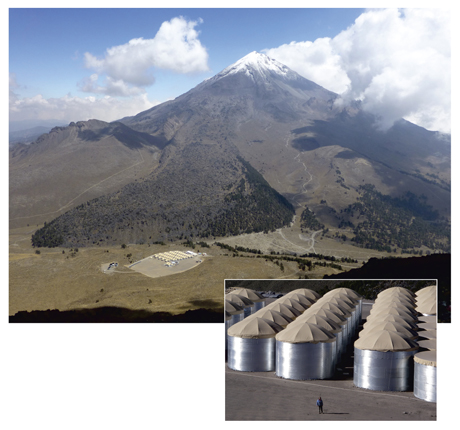Gamma-ray survey observatory starts up
DOI: 10.1063/PT.3.2142
Nestled at 4100 m on the slopes of Sierra Negra, an extinct volcano 200 km east of Mexico City, the High-Altitude Water Cherenkov Gamma-Ray Observatory (HAWC) began waiting for prey on 21 August. Mexico is providing the site and about a quarter of the $13.8 million for construction, with the US agencies NSF and the Department of Energy splitting roughly two-to-one the rest of the binational project’s cost.
HAWC is capable of finding “the highest-energy photons ever detected by man, and higher than what can be produced by man,” says Brenda Dingus of Los Alamos National Laboratory. “The gamma rays we detect are produced where particle densities are high, so it’s one of the best ways to look for high-energy particle sources.” Sensitive to gamma rays in the 100-GeV to 100-TeV range, HAWC detects the Cherenkov radiation emitted when showers of charged particles that the gamma rays create in the atmosphere fly through its water tanks at speeds faster than light.
The observatory’s main focus is to search for variable sources such as gamma-ray bursts and active galactic nuclei, plus higher-energy steady sources like supernova remnants, neutron stars, and subhalos of dark matter around the galaxy. In addition, says Dingus, at the highest energies, “gravity has to fail. Photons may be slowed down or sped up by quantum gravity. HAWC can look for variations in the arrival time to measure fractional velocity differences [in cosmic gamma rays] as a function of energy.”
HAWC runs day and night and can see about one-fifth of the sky; as Earth turns, the observatory passively surveys about two-thirds of the total sky. The wide field of view, allowing a general search for gamma-ray sources, “is our advantage,” says Alberto Carramiñana of Mexico’s National Institute of Astrophysics, Optics, and Electronics in Puebla. The Fermi Gamma-Ray Space Telescope has a larger field of view than HAWC, but observes at lower energies.
As of mid-September, HAWC had installed 130 of a planned 300 detectors—cylindrical tanks 7.3 m tall and 5 m in diameter, each outfitted with four photomultipliers and containing 180 000 liters of purified water. They form a close-packed array that will eventually be 150 m on a side. The observatory will be completed by the end of 2014, says Carramiñana. “But you can do good science with 100 tanks.”
Compared to its predecessor, the Milagro Gamma-Ray Observatory, which ran in New Mexico from 2000 to 2008, HAWC is at a higher altitude, has a larger total volume, and, with separate tanks rather than a single pool, has better angular resolution. Three-quarters of HAWC’s photomultiplier tubes, plus electronics and other parts, are salvaged from Milagro. Because of the large amount of data HAWC will collect—500 megabytes per second—its data acquisition system uses electronics that were developed for the Large Hadron Collider at CERN. The Sierra Negra site in Mexico won out over potential sites in Tibet, Bolivia, and Argentina; one reason was the infrastructure available thanks to another US–Mexico collaboration, the nearby Large Millimeter Telescope.

At the High-Altitude Water Cherenkov Gamma-Ray Observatory (above) in Mexico, about four light-tight detector tanks (right) will be added each week until 300 are in operation by late 2014.

More about the Authors
Toni Feder. tfeder@aip.org
